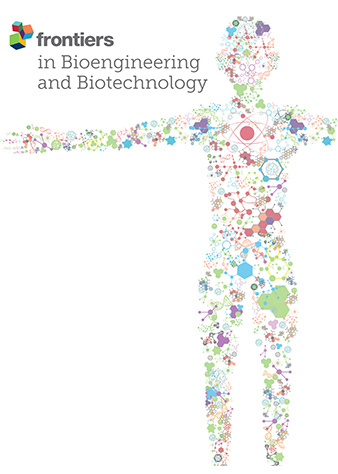A single sequence MRI-based deep learning radiomics model in the diagnosis of early osteonecrosis of femoral head
IF 4.3
3区 工程技术
Q1 BIOTECHNOLOGY & APPLIED MICROBIOLOGY
引用次数: 0
Abstract
PurposeThe objective of this study was to create and assess a Deep Learning-Based Radiomics model using a single sequence MRI that could accurately predict early Femoral Head Osteonecrosis (ONFH). This is the first time such a model was used for the diagnosis of early ONFH. Its simpler than the previously published multi-sequence MRI radiomics based method, and it implements Deep learning to improve on radiomics. It has the potential to be highly beneficial in the early stages of diagnosis and treatment planning.MethodsMRI scans from 150 patients in total (80 healthy, 70 necrotic) were used, and split into training and testing sets in a 7:3 ratio. Handcrafted as well as deep learning features were retrieved from Tesla 2 weighted (T2W1) MRI slices. After a rigorous selection process, these features were used to construct three models: a Radiomics-based (Rad-model), a Deep Learning-based (DL-model), and a Deep Learning-based Radiomics (DLR-model). The performance of these models in predicting early ONFH was evaluated by comparing them using the receiver operating characteristic (ROC) and decision curve analysis (DCA).Results1,197 handcrafted radiomics and 512 DL features were extracted then processed; after the final selection: 15 features were used for the Rad-model, 12 features for the DL-model, and only 9 features were selected for the DLR-model. The most effective algorithm that was used in all of the models was Logistic regression (LR). The Rad-model depicted good results outperforming the DL-model; AUC = 0.944 (95%CI, 0.862–1.000) and AUC = 0.930 (95%CI, 0.838–1.000) respectively. The DLR-model showed superior results to both Rad-model and the DL-model; AUC = 0.968 (95%CI, 0.909–1.000); and a sensitivity of 0.95 and specificity of 0.920. The DCA showed that DLR had a greater net clinical benefit in detecting early ONFH.ConclusionUsing a single sequence MRI scan, our work constructed and verified a Deep Learning-Based Radiomics Model for early ONFH diagnosis. This strategy outperformed a Deep learning technique based on Resnet18 and a model based on Radiomics. This straightforward method can offer essential diagnostic data promptly and enhance early therapy strategizing for individuals with ONFH, all while utilizing just one MRI sequence and a more standardized and objective interpretation of MRI images.基于单序列磁共振成像深度学习的放射组学模型在早期股骨头坏死诊断中的应用
目的 本研究旨在利用单序列核磁共振成像创建和评估基于深度学习的放射组学模型,该模型可准确预测早期股骨头骨坏死(ONFH)。这是首次将此类模型用于诊断早期股骨头坏死。它比之前发表的基于多序列核磁共振成像放射组学的方法更简单,而且采用了深度学习来改进放射组学。方法共使用了 150 例患者(80 例健康,70 例坏死)的 MRI 扫描图像,并按 7:3 的比例分成训练集和测试集。从特斯拉2加权(T2W1)磁共振成像切片中检索手工制作的特征和深度学习特征。经过严格筛选后,这些特征被用于构建三个模型:基于放射组学的模型(Rad-model)、基于深度学习的模型(DL-model)和基于深度学习的放射组学模型(DLR-model)。通过使用接收器操作特征(ROC)和决策曲线分析(DCA)对这些模型进行比较,评估了它们在预测早期 ONFH 方面的性能:辐射模型使用了 15 个特征,DL 模型使用了 12 个特征,而 DLR 模型只选择了 9 个特征。所有模型中最有效的算法是逻辑回归(LR)。Rad 模型的结果优于 DL 模型;AUC = 0.944(95%CI,0.862-1.000)和 AUC = 0.930(95%CI,0.838-1.000)。DLR 模型的结果优于 Rad 模型和 DL 模型;AUC = 0.968(95%CI,0.909-1.000);灵敏度为 0.95,特异性为 0.920。DCA显示,DLR在检测早期ONFH方面具有更大的临床净获益。结论利用单序列磁共振成像扫描,我们的工作构建并验证了一种用于早期ONFH诊断的基于深度学习的放射组学模型。这一策略优于基于 Resnet18 的深度学习技术和基于放射组学的模型。这种简单易行的方法可以及时提供重要的诊断数据,并加强对 ONFH 患者的早期治疗策略,同时只需利用一个 MRI 序列和更标准化、更客观的 MRI 图像解读。
本文章由计算机程序翻译,如有差异,请以英文原文为准。
求助全文
约1分钟内获得全文
求助全文
来源期刊

Frontiers in Bioengineering and Biotechnology
Chemical Engineering-Bioengineering
CiteScore
8.30
自引率
5.30%
发文量
2270
审稿时长
12 weeks
期刊介绍:
The translation of new discoveries in medicine to clinical routine has never been easy. During the second half of the last century, thanks to the progress in chemistry, biochemistry and pharmacology, we have seen the development and the application of a large number of drugs and devices aimed at the treatment of symptoms, blocking unwanted pathways and, in the case of infectious diseases, fighting the micro-organisms responsible. However, we are facing, today, a dramatic change in the therapeutic approach to pathologies and diseases. Indeed, the challenge of the present and the next decade is to fully restore the physiological status of the diseased organism and to completely regenerate tissue and organs when they are so seriously affected that treatments cannot be limited to the repression of symptoms or to the repair of damage. This is being made possible thanks to the major developments made in basic cell and molecular biology, including stem cell science, growth factor delivery, gene isolation and transfection, the advances in bioengineering and nanotechnology, including development of new biomaterials, biofabrication technologies and use of bioreactors, and the big improvements in diagnostic tools and imaging of cells, tissues and organs.
In today`s world, an enhancement of communication between multidisciplinary experts, together with the promotion of joint projects and close collaborations among scientists, engineers, industry people, regulatory agencies and physicians are absolute requirements for the success of any attempt to develop and clinically apply a new biological therapy or an innovative device involving the collective use of biomaterials, cells and/or bioactive molecules. “Frontiers in Bioengineering and Biotechnology” aspires to be a forum for all people involved in the process by bridging the gap too often existing between a discovery in the basic sciences and its clinical application.
 求助内容:
求助内容: 应助结果提醒方式:
应助结果提醒方式:


